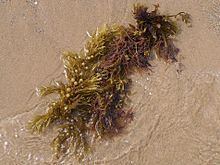Domain Eukaryota | Superphylum Heterokonta Scientific name Sargassum muticum Rank Species | |
 | ||
Similar Sargassum, Brown algae, Fucales, Sargassaceae, Cystoseira | ||
Reproduction in sargassum muticum
Sargassum muticum, commonly known as Japanese wireweed, is a large brown seaweed of the genus Sargassum. It is an invasive seaweed with high growth rate (until 10 cm per day during spring). It has an efficient dispersion thanks to its floats.
Contents
- Reproduction in sargassum muticum
- Nscm i press play 2016 sargassum muticum a change for better cultivation young explorers club
- Description
- Reproduction
- Habitat
- Repartition areas
- Invasiveness and impacts
- Options of removal
- Valorization
- References
Nscm i press play 2016 sargassum muticum a change for better cultivation young explorers club
Description
Sargassum muticum is a brown seaweed, normally brown to yellowish with a length up to 10 m. It is an autotroph that uses energy from sunlight. The photosynthesis is facilitated thanks to aerial vesicles which allows the algae to raise to the surface.
Sargassum muticum is composed of two distinct parts: a perennial part, which contains the holdfast and one or more short main axes; and an annual part: the secondary axes, which develop on the main axis, whose growth is unlimited and the size is variable. There are three types of ramifications: laterals with foliaceous expansions called fronds, laterals with fronds and aerocysts and laterals with fronds, aerocysts and reproductive organs called receptacles. In winter, only the perennial part persists (5 cm). In summer, the lateral part is in maximum development of 2–3 meters to 10 meters.
Reproduction
The mode of reproduction is both sexual and asexual. S. muticum reaches sexual maturity in the summer when gamete production takes place in receptacles. The species is monoecious, ie an individual is capable of producing male and female gametes. Its cycle of development is monogenic (ie only one generation is present during its life cycle). At the level of fertilization: male gametes are dispersed in seawater while female gametes remain in the receptacle where fertilization takes place). Development is also done at the receptacle and then once at the stage of seedling, the latter is detached for fixation on a new support and form a new individual. This species can also reproduce asexually. But this has never been observed in temperate environments.
Habitat
Sargassum muticum grows from half-tide to infralittoral areas (to a depth of 10 m.). It is fixed on solid substrates like rocks, stones, shells. It is highly tolerant towards temperature and salinity variations. The optimal temperature is between 17 and 20 °C but it tolerates -9 and 30 °C.
Repartition areas
Originally from Japan, it is thought to have gained worldwide distribution through being transported with Japanese oysters (Crassostrea gigas). Sargassum muticum was introduced to the Californian coast in the 40's and in Europe in the 70's (The species was first found in the British Isles in the Isle of Wight in 1973). Currently, the alga is widespreaded from Norway to Portugal along Atlantic's coasts. Sargassum muticum has a range stretching from Campbell river, British Columbia to Baja in California. In Europe it extends along the coasts of Great Britain, France, Scandinavia, Baltic Sea, Helgoland, Netherlands, Ireland, the Iberian Peninsula and into the Mediterranean from Italy and the Adriatic. It is recorded from Japan, China and Alaska. Recently, some specimens were find on Moroccan coasts. It illustrates its huge tolerance regarding to its environments. Herbarium specimens are now stored in the Ulster Museum (BEL catalogue numbers: F11241 - F11242; F11182 - F11185).
Invasiveness and impacts
Its proliferation is important especially during the summer, which causes economical and ecological problems.
Ecological: Because of its large size and dense ramifications, S.muticum forms a screen within the water column preventing the penetration of light. It also captures the nutrients in disfavor of other species such as phytoplankton. However, S.muticum also serves as shelter and protection for fish larva or crustaceans as well as laying support for cuttlefish.
Economical: S.muticum fixes itself to the shells of oysters creating problems in shellfish farming through increased manual work to eliminate the algae. In addition, it can wrap around the farming structures, requiring additional maintenance. It also gets entangled with the propellers of the boats.
Options of removal
Mechanic: Grubbing-up. But it favors the dissemination and the technic is a work-intensive.
Chemical: The use of herbicides is advised against because the risk to the environment and others organisms is too important.
Biological: They are few of natural predators, one example is a little copepod that will eat only the unhealthy and damaged part of S. muticum.
Currently, the distribution is stabilized and only mechanical removal is performed.
Valorization
There are some potential ways of valorization for Sargassum muticum.
In agriculture, algae are used as sources of nitrate and potash for fertilization.
Water treatment: the cell walls of S. muticum contains alginates and fucoidans. The association of both molecules forms a bigger molecule and this one can be a flocculant. This process can be a method to catch organic matter present in sewage. This flocculant, rich in proteins and oligoelements, is easily biodegradable and could be used for fertilizer.
Previous studies have shown that Sargassum muticum is able to do biosorption of heavy metals like cadmium, chlorophenolic compounds, and nickel...
Antifouling: Secondary metabolites product by marine algae could be an interrested altrernative . Previous studies have shown the potential of hydrocarbon and fatty acid compounds about antifouling activities, as galactolipids, palmatic acid, 1-tetradecene or 1-hexadecene... Moreover, there is a pic of production of antifouling compounds during spring.
Antioxidant compounds: Sargassum muticum is rich in antioxidant compounds like phenolic compounds (cathechins, phlorotannins, quercetins), pigments (fucoxanthin) and vitamins(vitamin C, K, E in the forme of alpha-tocophérol and gamma-tocopherol). Applications are possible in pharmaceutics, cosmetics and health fields thanks to the antioxidant activities of these molecules.
